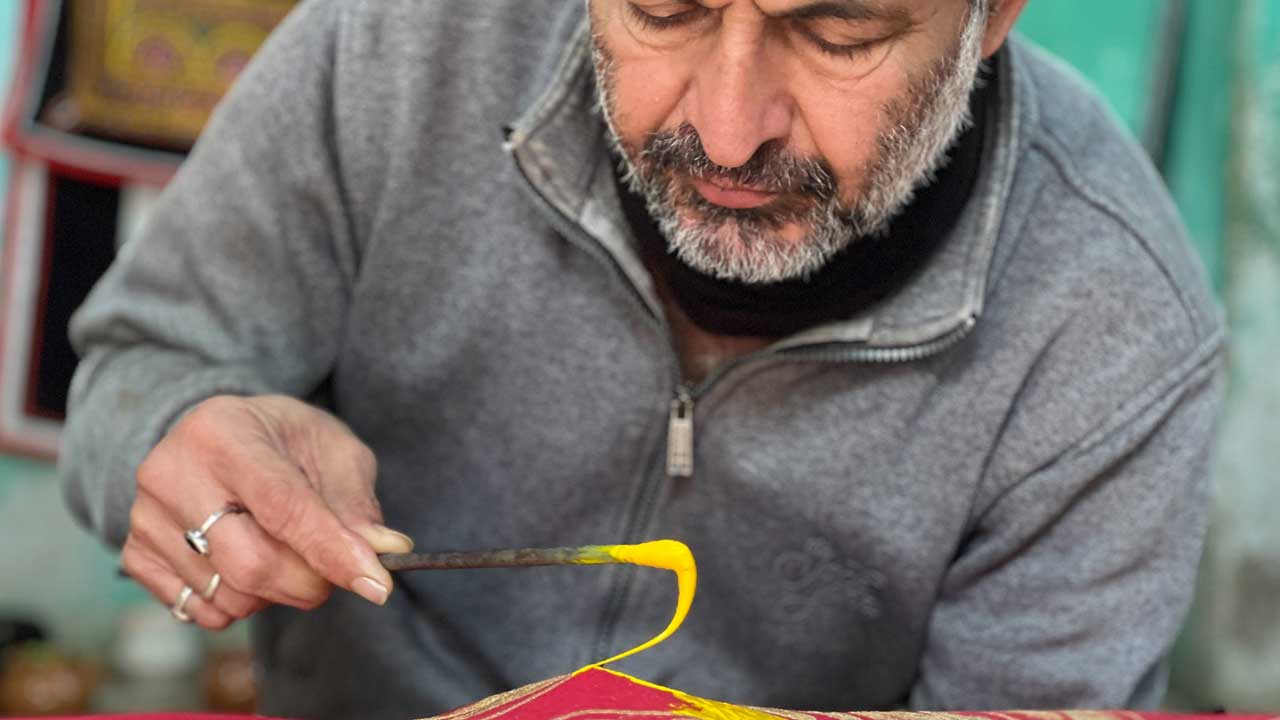In the heart of Gujarat’s Kutch region, a remarkable art form thrives against all odds. This is thanks to the unwavering dedication of one man: Ashish Kansara. He is not just an artist. He is a custodian of Rogan art. This is a rare and ancient craft passed down through generations of his family.

What is Rogan Art?
Rogan art is a 1,550-year-old textile painting technique with a history as rich as the designs it creates. The name “Rogan” is derived from a Sanskrit word “rangan” meaning “to add colour” or “to dye”. This intricate process involves creating a thick, glossy paste. The paste is made by boiling castor oil for 5 to 6 hours. Then, it is mixed with natural pigments. The artist then uses a thin metal rod, or stylus, to draw freehand. They pull the paste into fine threads to form elaborate and stunning patterns on fabric. The final result is a masterpiece of raised, vibrant art that is both tactile and beautiful.
A Family Legacy of Resilience | Ashish Kansara
For Ashish Kansara, Rogan art is not just a profession; it’s a family legacy. Born in Ahmedabad, he learned the craft from his grandfather, Jamnadas Vastaram Kansara, who was a master of the art. Although there was a period of decline after the 2001 Kutch earthquake, Ashish refused to let the tradition die. During this time, the demand for traditional Rogan art products like wedding lehengas and saris dwindled. He temporarily worked in other fields. Yet, his passion for Rogan art, the craft revived by Ashish Kansara, remained strong.
He made the courageous decision to innovate. He applied the traditional art form to modern products like home decor, wall pieces, and contemporary clothing. This vision breathed new life into Rogan art. It made it relevant to a new generation of art lovers.

Innovating While Preserving Rogan Art
Ashish Kansara’s work stands out not only for its technical brilliance but also for his unique artistic vision. While Rogan art traditionally features nature-inspired motifs like the “Tree of Life,” Ashish has pioneered a new genre. People celebrate him for creating stunning portraits and paintings of deities like Shri Rama, Shri Swaminarayan, and Shri Mahavir. No one had ever seen this style before in this art form. He is also a master of “Rogan Chhap,” a technique of creating prints using brass molds.
Empowerment and the Future of Rogan Painting
Beyond his personal artistry, Ashish, the renowned Ashish Kansara, is a champion of social empowerment. He and his wife, Komal Kansara, have taken on the crucial role of teaching and preserving the craft. Breaking traditional norms, they have trained a group of women in their village of Madhapar, Kutch, to practice Rogan art. This provides them with a sustainable livelihood and ensures the art’s survival. This collective effort has turned their small village into a hub for this ancient craft.
Ashish Kansara’s journey is a powerful testament to the fact that tradition is not a static relic of the past. In fact, it is a living, breathing art form, which means it can evolve and adapt. Through his dedication, skill, and commitment to his community, he is ensuring that the intricate threads of Rogan art continue. Generations to come will weave them into the cultural tapestry of India.
Moreover, if you ever find yourself in the Kutch region, you should not miss a visit to his workshop. This is where Ashish Kansara creates his magic. You can witness the magic of Rogan art first-hand. See a living piece of history being created right before your eyes.